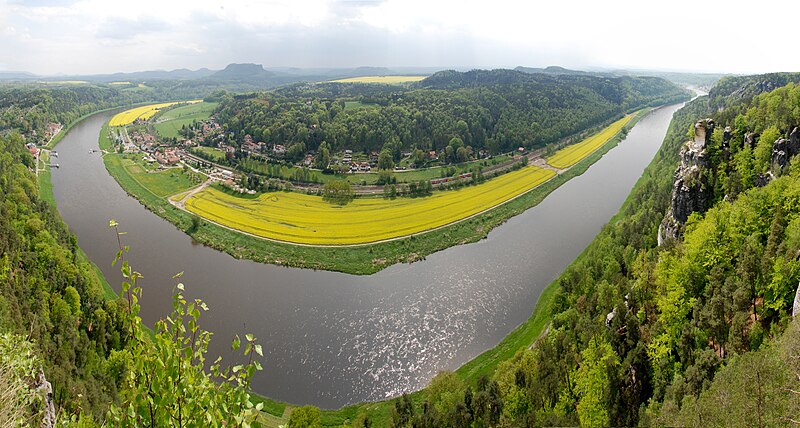The Elbe River: A Historic Waterway Binding Germany and the Czech Republic

An Elbe elbow...
Flowing majestically through the heart of Central Europe, the Elbe River stands as a symbol of history, culture, and natural beauty, serving as a vital lifeline for the peoples of Germany and the Czech Republic. Stretching over 680 miles (1,094 kilometers), the Elbe winds its way through picturesque landscapes, historic cities, and vibrant cultural centers, leaving an indelible mark on the regions it traverses.
Geographical and Historical Significance: The Elbe River originates in the Krkonoše Mountains of the Czech Republic, near the border with Poland, and flows northwestward through the lush countryside of Bohemia. It passes through major cities such as Dresden, Magdeburg, and Hamburg before emptying into the North Sea near Cuxhaven.
Throughout history, the Elbe has been a vital artery for trade, transportation, and commerce, linking the heartlands of Central Europe to the ports of the North Sea. In ancient times, it formed the eastern frontier of the Holy Roman Empire and witnessed the rise and fall of medieval kingdoms and empires. The riverbanks are dotted with historic towns, castles, and fortresses, each bearing witness to the rich tapestry of European history and civilization.
Cultural and Artistic Legacy: The Elbe has inspired generations of artists, writers, and musicians with its timeless beauty and romantic allure. From the epic symphonies of Bedřich Smetana’s “Die Moldau” to the haunting melodies of Johann Sebastian Bach’s “Air on the G String,” the river has been a source of inspiration for countless works of art and literature. Painters such as Caspar David Friedrich and Canaletto captured its scenic vistas and vibrant landscapes in their masterpieces, while writers like Johann Wolfgang von Goethe and Franz Kafka chronicled their journeys along its banks in their novels and essays.
The cities and towns along the Elbe are home to a wealth of cultural treasures, from the Baroque palaces of Dresden and Prague to the Gothic cathedrals of Magdeburg and Wittenberg. The region’s architectural heritage reflects the diverse influences of Romanesque, Gothic, Renaissance, and Baroque civilizations, creating a unique blend of styles and traditions that is truly emblematic of Central European culture.
Economic Importance: The Elbe River is not only a cultural icon but also a vital economic artery for Germany and the Czech Republic. Its navigable waters facilitate the transportation of goods and commodities, including coal, steel, and agricultural products, supporting industries such as manufacturing, agriculture, and logistics. Ports along the river, such as Hamburg and Dresden, are major hubs for domestic and international trade, handling millions of tons of cargo each year.
The Elbe also plays a crucial role in the region’s tourism industry, attracting millions of visitors each year with its scenic beauty, historic landmarks, and vibrant cultural scene. River cruises offer travelers a leisurely way to explore the river’s many attractions, from the medieval castles of Saxon Switzerland to the modern architecture of the HafenCity in Hamburg.
Environmental Conservation and Sustainability: In recent years, efforts have been made to protect and preserve the ecological health of the Elbe River and its surrounding habitats. Initiatives to reduce pollution, restore wetlands, and promote sustainable development aim to ensure that future generations can continue to enjoy the river’s natural beauty and resources.
From hiking and cycling along its scenic riverbanks to birdwatching and kayaking along its tranquil waters, the Elbe offers endless opportunities for outdoor recreation and exploration. Whether exploring historic landmarks, sampling local cuisine, or simply soaking in the breathtaking views, visitors to the Elbe region are sure to be captivated by its timeless charm and allure.
Conclusion: In conclusion, the Elbe River stands as a symbol of Central Europe’s natural beauty, cultural richness, and historical significance. From its source in the Krkonoše Mountains to its delta in the North Sea, the river’s journey reflects the enduring spirit of the German and Czech peoples and the timeless rhythms of the natural world. As we navigate the challenges of the 21st century, the Elbe remains a source of inspiration, fascination, and pride for all who encounter its majestic waters.




